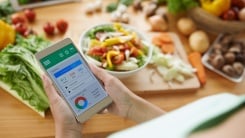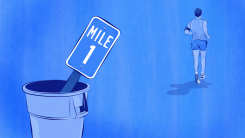How to Accurately Count Calories (and Why You Might Want To)

If you want to start tracking how many calories you eat—whether for weight loss, weight gain, or just out of curiosity—here’s a primer. Calorie tracking is pretty easy once you’ve gotten the hang of it, but getting started can be confusing. With the right tools and the right habits, however, you’ll be on top of your own personal calorie numbers in no time.
What are calories and why do people count them?
Calories are a measure of energy. The more exercise you do, for example, the more calories you need to fuel that activity. Everything you eat has a calorie number attached to it (whether it’s on a label or not). In general, we eat about the same number of calories we burn.
Amazingly, our bodies can keep us at a roughly steady weight by making us hungrier if we haven’t eaten enough calories today, or making us feel full if we’ve had a lot. That said, consistently eating less than you burn results in weight loss; eating more than you burn results in weight gain.
How do I know how many calories I should eat?
Most of the time, you should eat roughly the same number of calories each day that your body burns. That number varies from person to person. A 4’9”, 100-pound woman who only does light exercise might burn 1,440 calories per day. A six-foot, 280-pound man who does heavy workouts twice a day might burn 4,309. Most of us are somewhere in between, in the 2,000 to 3,000 calorie range.
I discuss calorie burn a little more here. Even though food labels use a 2,000-calorie diet to calibrate their “daily values” of various nutrients, the truth is that we each burn a different number of calories, and most of us burn more than 2,000. (The average for adults was, years ago, calculated to be 2,350. The FDA ended up going with 2,000 in part because they thought a round number was easier to understand.)
So if you would like to lose weight, you’ll want to eat slightly less than you burn. If you want to gain weight—as many people do when they’re trying to gain muscle—you’ll want to eat more calories than you burn. A good rule of thumb is to subtract 200-500 calories from what you burn, and that will be a good number for weight loss. Do the opposite if you’re trying to gain.
Now that you understand the logic, you just need a starting estimate of how many calories you burn. If you already track calories, you can probably figure this out by what you usually eat when your weight is stable. Otherwise, plug your information into a TDEE (total daily energy expenditure) calulator like the one at tdeecalculator.net. Remember that any calculated number is only an estimate, and ultimately you’ll find out whether it’s correct by noticing what happens to your weight when you eat that number.
If you use a Fitbit or other gadget that estimates your calorie burn each day, that’s also a good place to get a starting number. Just remember that this is also an estimate, and could still be off by a few hundred calories in either direction.
How do I find out how many calories are in a food?
The easiest way to get a calorie number for a food is to look at its label. Or if your food doesn’t have a label, search for the name of the food plus “calories” and pay attention to the serving size and the source of the information. For example, when I google “apple calories,” I get a result telling me that a medium apple, about 3 inches in diameter, is 95 calories. The source is given as the USDA, which maintains a database of common food items. Here’s the entry for apples. It defaults to a 100-gram serving, but you can change the “portion” dropdown to show you the medium apple.
When you’re eating at a restaurant, calorie counts are sometimes shown next to each food item. If they aren’t, check the restaurant’s website, or search the restaurant’s name plus “nutrition information.” Often there’s a PDF hidden somewhere on their website with a bunch of calorie counts—and, often, other information like protein and carbohydrate content.
That said, there’s a simpler way that people usually use when tracking calories: You use a calorie tracking app.
What is the best calorie tracking app?
There are tons of good (or at least not horrible) calorie tracking apps out there. Cronometer is my pick: It’s got all the features you need even in the free version, and it’s goal-neutral, so you can use it whether you’re trying to gain weight, lose weight, or neither.
The most popular calorie tracking app is probably MyFitnessPal, which is baffling because it’s easily the worst one out there. The calorie information is often inaccurate, the interface is pretty in-your-face about weight loss whether you’re interested in that or not, and basic features like the barcode scanner are only available in the paid version. We have a roundup of alternatives to MyFitnessPal here.
When you use a calorie tracking app, you’ll search within the app for the food that you just ate (or that you’re about to eat). At first you’ll find this practice clunky: You’ll have to choose the right item from the database, and then try to figure out how large a serving you just ate. Packaged foods are easiest to track, which adds an extra wrinkle if you’re also trying to eat more whole or homemade foods. Bear with this, though: Habits are skills, and as you develop all the mini-skills that make up calorie tracking, the habit becomes second nature.
How do I select an accurate serving size for the food I’m tracking?
As you gain more practice, you’ll get pretty good at eyeballing serving sizes. But as you’re getting used to it, make a habit of measuring or weighing food when you can. At this point I can pretty accurately eyeball the difference between a cup of rice and a half-cup of rice, for example. I know that a three-ounce serving of meat is about the size of a deck of cards, or a little smaller than the palm of your hand (depending, I suppose, on how big your hand is). A “serving” of peanut butter is two tablespoons; measure this out at least once so you can get a sense of whether your usual serving is more or less than that.
To be more precise, you can start using a food scale. This makes your life easier in so many ways. For example, you can:
-
Place your toast on the scale, zero it, and then spread on the peanut butter. Weigh the peanut-buttered toast, and you’ll know exactly how many grams of peanut butter you used.
-
Weigh out your desired portion of chicken, vegetables, or anything else you’re eating.
-
Portion a meal equally by weighing the whole thing, and then weighing each portion so that it contains ¼ of the total (if you’re making a four-serving meal).
-
Place a container of, say, yogurt on the scale, and zero it. Then you can scoop yogurt from that container into the blender as you’re making a smoothie. This requires a “negative tare” feature, but it’s great for when you’re adding ingredients to containers you can’t weigh directly, like a blender or a pot on the stovetop. You just weigh the container the food is coming from.

$9.99
at Amazon

How do I count the calories in homemade food?
Your calorie tracking app should have a way of creating a recipe. Add in the ingredients, and make sure to say how many servings the recipe makes if you’re cooking for a group or making multiple servings for meal prep. Make sure to include all the ingredients, including cooking oil and condiments.
How do I count calories in a meal somebody else made?
If you don’t know exactly what’s in something, you can guess. The easiest way is to look up a restaurant food that is similar and eyeball the portion.
What do I do if there’s an oil or sauce with my food and I don’t eat all of it?
Unfortunately there’s no easy adjustment to make here. Maybe you’re leaving a ton of calories behind, but it will be hard to separate that out mathematically from the other components that you did eat. In this case I just pretend I ate the whole thing, sauce and all. If there’s a ton of sauce and I’m sure I’m leaving lots of calories behind, I’ll log it as 0.9 instead of one serving.
Do I need to track everything, every day?
There are no food-tracking police (thank god), so no, you don’t have to do anything. But if you’re trying to get a roughly accurate estimate of how many calories you eat each day, you really should log everything, as much as you can. If you snack on a cookie, put a cookie into your app.
I’ll sometimes skip an entire day of tracking, but I won’t log a partial day. If I eat 1,200 calories before dinner, and then go to a party and eat 15 different little things that are impossible to accurately track, I might say “fuck it” and delete the whole day. But I wouldn’t leave it at 1,200, because looking back, it will seem like that entire day was only 1,200 calories. If I know I ate more than usual and I want to make sure my tracking shows it, I’ll pick a placeholder like a restaurant meal (my app actually has an entry for “Thanksgiving”) and log whatever gets me, say, 3,000 calories of that.
Along the same lines, it’s tempting to not log things you think you “shouldn’t” be eating, but this backfires. In reality, if I’m eating 2,500 calories and only logging 2,000, I would look at my app and think, wow, I’m eating 2,000 calories and not losing weight. I would start to feel like I needed to eat even less than 2,000, and I might fall into one of those vicious cycles of restricting myself to smaller meals and then finding myself eating more untracked “cheat” meals. This is not a healthy way of eating, and tends to get worse over time. Instead, I log it all. If I know I’m eating 2,500 calories and not losing weight, I would be able to appreciate the fact that my body can put 2,500 calories to good use every day. I would then eat slightly less—maybe 2,200—and see if that might be a more effective and sustainable approach.
Or to put it another way: if you log everything, you can be honest with yourself and kinder to yourself. You just have to look at the numbers as neutral data, not as a judgement on whether you’re being “good.”



